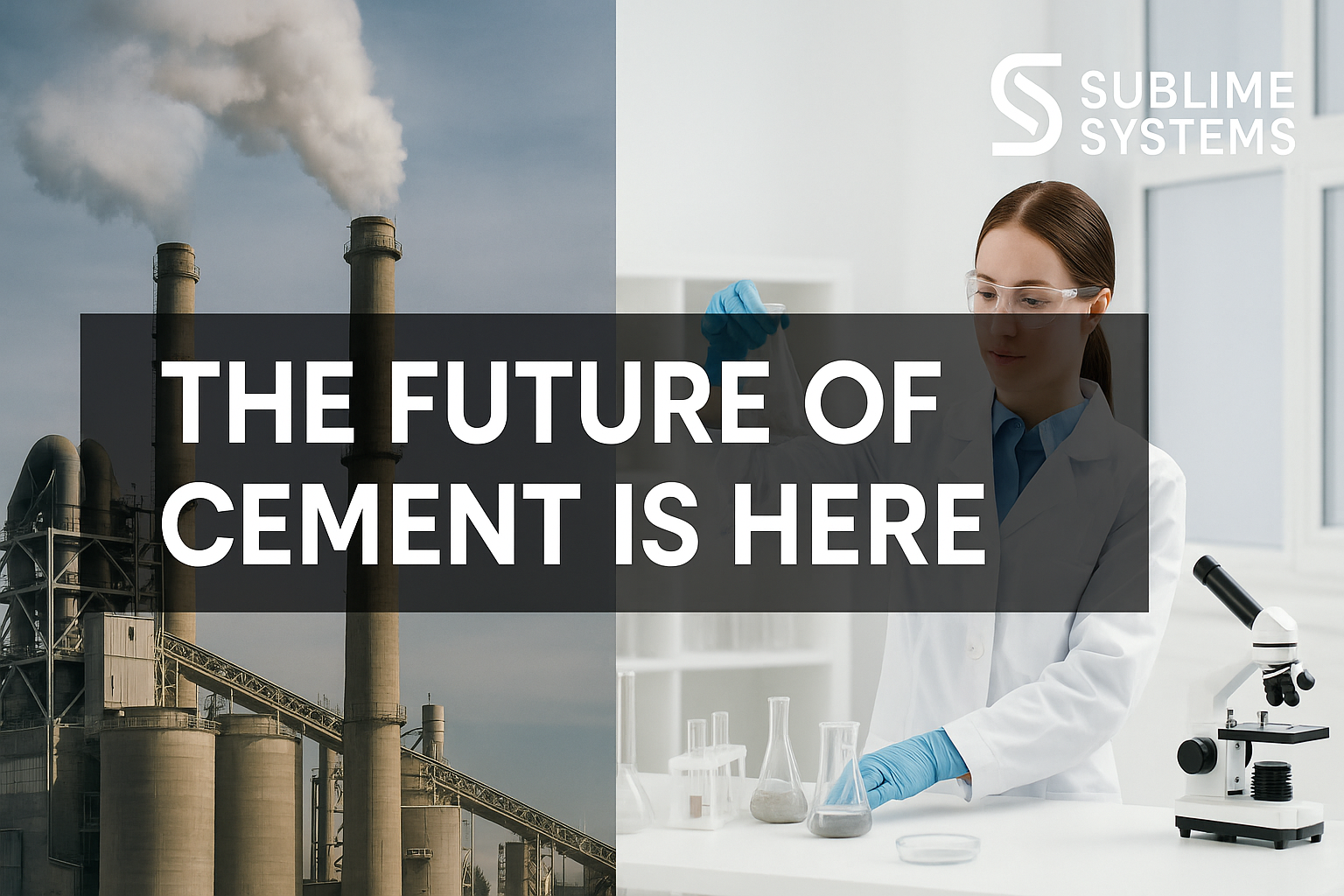
Reinventing Cement: How Sublime Systems Is Slashing COâ‚‚ Emissions in Construction
Cement is the unsung hero of modern construction"”essential to every skyscraper, bridge, and sidewalk. But it also comes with a massive environmental cost.
Cement production alone contributes around 8% of global COâ‚‚ emissions, primarily due to the energy-intensive process of heating limestone to extreme temperatures.
Enter Sublime Systems, a U.S.-based cleantech startup that's shaking up the industry with a revolutionary approach: electrochemical cement production. By eliminating the need for heat altogether, Sublime offers a greener, scalable alternative that could transform the future of construction.
🔬 The Problem: Cement and Climate Change
Cement's carbon footprint comes from two main sources:
- Calcination "“ Heating limestone (calcium carbonate) to over 2550°F releases COâ‚‚ directly from the rock.
- Combustion "“ Fossil fuels are burned to reach those temperatures, releasing more COâ‚‚.
Together, these processes account for 8% of all global carbon emissions"”more than the airline and shipping industries combined. As construction continues to expand worldwide, particularly in urbanizing economies, the problem is only growing.
âš¡ The Solution: Sublime Systems' Electrochemical Process
Founded in 2020 by MIT researchers Leah Ellis and Yet-Ming Chiang, Sublime Systems replaces traditional cement kilns with electrochemical reactors. These reactors extract calcium and silicates from raw minerals or even industrial waste, bypassing the need for heat.
Key Innovations:
- No Kilns, No COâ‚‚: Sublime doesn't heat limestone. Instead, it uses renewable electricity to separate calcium from other elements in rock, avoiding COâ‚‚ emissions altogether.
- Versatile Feedstock: The process works with naturally occurring materials and industrial by-products, improving resource efficiency.
- Chemical Shift, Not Performance Shift: Though the end product has a different chemical structure than Portland cement, it matches or exceeds traditional standards in strength, durability, and setting time.
Emissions Reduction:
Sublime's method cuts carbon emissions by up to 90%, making it one of the most impactful innovations in construction materials to date.
ðŸ From Pilot to Commercial Scale
Sublime Systems currently operates a pilot plant in Massachusetts with an annual output of 250 tons of cement. While this is modest, a larger commercial plant is scheduled to open in 2026, capable of producing 30,000 tons annually.
Funding & Backing:
Sublime has attracted over $200 million in funding from prominent investors, including Bill Gates' Breakthrough Energy Ventures and climate-focused funds. Their rapid progress is a strong signal of market readiness and investor confidence.
🔄 Part of a Bigger Trend: Sustainable Construction
Sublime's rise isn't happening in isolation. The company is part of the broader Sustainable Construction meta trend"”a movement to decarbonize the built environment.
Key Stats:
- The construction sector accounts for 11% of global emissions.
- Nearly 60% of industry leaders say sustainability will dominate the sector over the next five years.
🌠Other Startups Leading the Charge
Here are a few other innovative players tackling emissions in construction:
1. Rondo Energy
- Innovation: A heat battery that stores and delivers high-temperature air using renewable energy.
- Use Case: A Rondo battery is already being deployed at a cement plant in Thailand.
2. JUUNOO
- Innovation: Modular and reusable office walls that reduce material waste.
- Upcoming Product: "Clickable drywall" designed for quick assembly, disassembly, and reuse.
3. Paebbl
- Innovation: Captures COâ‚‚ and converts it into building materials.
- Timeline: A pilot plant is already live, with commercial production expected in 2027.
🧱 Why It Matters
Cement is foundational to human infrastructure"”but if we don't reinvent it, it may also become foundational to climate collapse. What makes Sublime Systems stand out is not just its innovative technology, but the readiness for scale, industry-standard performance, and massive emissions savings.
ðŸ› ï¸ What's Next?
The road ahead for Sublime Systems includes:
- Launching its first commercial-scale facility by 2026.
- Expanding feedstock sources to industrial waste materials for added circularity.
- Gaining certifications and industry partnerships to enable adoption at large construction firms.
🔑 Final Thoughts
The construction industry has long been labeled a climate laggard. But companies like Sublime Systems are proving that climate-friendly alternatives don't require performance compromises. As sustainable construction accelerates, expect Sublime to become a household name"”not just in cleantech, but across the global infrastructure landscape.
Jaspal Singh
Elite AuthorI am a full-time #Blogger, #WebDesigner #SEO and #WordPress expert living in #Jaipur and I love to learn new things, right now trying my hands on #VideoEditing.
Jaspal Singh
I am a full-time #Blogger, #WebDesigner #SEO and #WordPress expert living in #Jaipur and I love to learn new things, right now trying my hands on #VideoEditing.
EXPERTISE AREAS
Discover More

Most Imaginative Photo Manipulation Examples of All Time
We’re living in an era where literally nothing is what it seems online. Your feed is probably ...

How to Clean Your E-Cigarette: The Complete Guide
Why Cleaning Your E-Cigarette Matters If you’re among the millions of Americans who use e-ciga...

Benefits of Implementing Automated Warehouse Systems
Today, we’re talking about warehouses. You know those massive buildings where packages go to hang ...

How Los Angeles Architects Balance Client Desires with Practical Constraints
Los Angeles, with its diverse neighborhoods and dynamic architecture, has a rich history reflecting ...

Blinds in Commercial Spaces: How To Choose the Right Window Coverings
When enhancing the look, feel, and functionality of commercial spaces, the right window coverings ca...

Beyond the Basics: Fresh Ways to Connect with Local Swingers and Clubs in 2024
The swinging lifestyle has become increasingly visible and accepted over time, drawing in people of ...